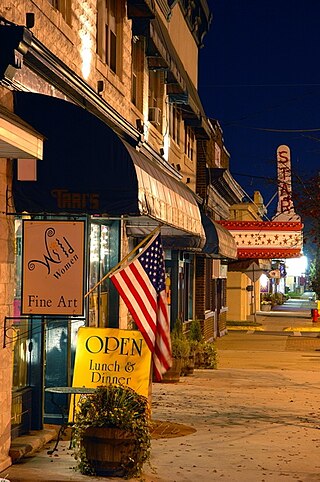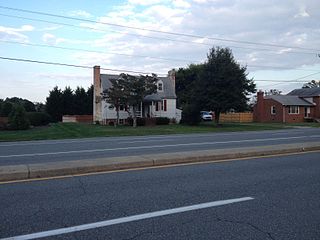
The C.H. Brown Cottage is a historic house at 34 Wright Street in Stoneham, Massachusetts. Probably built in the 1830s, it is a well-preserved example of worker housing built for employees of local shoe factories. It was listed on the National Register of Historic Places in 1984.

The Roosevelt Point Cottage and Boathouse are located on the Hudson River near the end of River Point Road in Hyde Park, New York, United States. They were both built around 1860 as part of Rosedale, the estate of Isaac Roosevelt, grandfather of Franklin D. Roosevelt.

Morton House, also known as Morton Mansion, is a historic home with Queen Anne style located at Webster Springs, Webster County, West Virginia that dates to 1912. It is a massive red brick dwelling set on a solid stone foundation, with a hipped roof and features a pair of 2+1⁄2-story turrets and each is topped with a conical shingled roof and capped with wooden finials. It also has a wraparound porch around 3/4 of the house.

The Architecture of Buffalo, New York, particularly the buildings constructed between the American Civil War and the Great Depression, is said to have created a new, distinctly American form of architecture and to have influenced design throughout the world.

Town of Bath Historic District is a national historic district located at Berkeley Springs, Morgan County, West Virginia. The district encompasses 218 contributing buildings, 3 contributing sites, 6 contributing structures, and 1 contributing object. It consists of the community's central business district, along with the previously listed Berkeley Springs State Park, a small industrial area east of the downtown, and residential areas surrounding the downtown which also contain several churches and two cemeteries. The buildings are generally two stories in height and are primarily built of brick, wood, and concrete block, and set on foundations of native limestone and brick. Located within the district boundaries are the previously listed Berkeley Springs Train Depot, T. H. B. Dawson House, the Clarence Hovermale House also known as the Mendenhall 1884 Inn, the Sloat-Horn-Rossell House, and the Judge John W. Wright Cottage.

Hays-Gerrard House is a historic home located at Gerrardstown, Berkeley County, West Virginia. It was built about 1743 and is a two-story, three bay wide limestone dwelling. It measures 16 feet by 27 feet and has a steeply pitched gable roof. The property was the site of the first Baptist church in the area and home to Rev. John Gerrard, first Baptist minister west of the Blue Ridge Mountains. The house was restored in the 1970s.
Stuckey House is a historic home located near Jones Springs, Berkeley County, West Virginia. It was built in the 1820s, and is a two-story, three-bay, central block of cut limestone, with a 1+1⁄2-story rubble limestone, three-bay wing. The house dates to the Federal period and has a steeply sloped gable roof. Also on the property is a limestone springhouse, log smoke house, and "necessary".

The W. Scott Stuart House is a historic home located at West Union, Doddridge County, West Virginia. It was built about 1905, and is a three-story, frame dwelling, with a two-story front portico with Ionic order columns, wrap-around porch, and an opulent interior in a transitional Queen Anne style. It features circular twin towers located on each front corner with tile conical roofs.

Gen. I.H. Duval Mansion, also known as the General I.H. Duval House No. 4 and Charles D. and Marjorie Bell Residence, is a historic country home located at Wellsburg, Brooke County, West Virginia. It was built in 1858, and is a two-story, five bay, rectangular brick dwelling with a hipped roof in the Greek Revival style. It features a three bay portico with a hipped roof and supported by squared Tuscan order columns. It was built by American Civil War General and Congressman Isaac H. Duval (1824-1902).
Mill Island, also known as the Seymour Family House, is a historic home located near Moorefield, Hardy County, West Virginia. The original brick cottage was built in 1798. In 1840, a two-story, brick Greek Revival style mansion was appended. The 3+1⁄2-story building features a one bay, temple style entrance porch and a "widow's walk" on the roof peak. The porch columns are in the Corinthian order. The interior features a great ballroom, reception hall, parlors, and a huge dining room. During the American Civil War, it was used as a hospital by the McNeill's Rangers.

Ford House is a historic home located at Morgantown, Monongalia County, West Virginia. It was built about 1868, and is a 1+1⁄2-story, "L" shaped Gothic Revival style cottage. It features a steeply pitched gable roof, a Gothic arched window in the center gable, and lattice work in lieu of bargeboard on the front porch.

John McLure House, also known as the Hans Phillips House, Lawrence Sands House, and Daniel Zane House, is a historic home located on Wheeling Island at Wheeling, Ohio County, West Virginia. It was built between 1853 and 1856 [when the island was a part of Virginia], and is a three-story, Federal-style brick dwelling. A two-story rear addition was built before 1870. A semi-circular columned portico and two-story, projecting side bay, were added in the late 19th century and added Classical Revival elements to the home.

Gaymont is a historic home located near Aurora, Preston County, West Virginia. It was built about 1896 as a summer resort cottage. It is a two-story, "T"-shaped dwelling constructed of wood, wood shingles, wood half-timbers, and cut stone. It displays eclectic overtones of American Craftsman, Rustic, and Queen Anne architectural styles. It features a low-pitched, cross-gabled, and hipped roof and wraparound, Queen Anne style verandah.

Henderson Hall Historic District is a National Register of Historic Places (NRHP)-listed historic district in Boaz, Wood County, West Virginia. The primary contributing property is Henderson Hall, a home in the Italianate style from the first half of the 19th century. Other residences at the site are a tenant house from the end of the 19th century, and "Woodhaven", the 1877 home of Henry Clay Henderson. Additional structures include a smokehouse, two corn cribs, a carriage barn that also served as a schoolhouse, a scale house used for storing agricultural equipment, and two barns. Also included within the district are the 19th-century Henderson family cemetery, a wall, a mounting block, and three mounds associated with the pre-Columbian Adena culture.

Lowland Cottage is a historic home located near Ware Neck, Gloucester County, Virginia. The main and earliest part of the house, considered to have been built between 1666 and 1676, is a gambrel roofed, 1+1⁄2-story structure, approximately 40 feet by 20 feet. Sometime between 1783 and 1831 Lowland Cottage received two additions: a 1+1⁄2-story gambrel-roofed wing on the east end, and a two-story wing on the north side. The house was remodeled in 1935.

Cool Well is a historic home located near Mechanicsville, Hanover County, Virginia. It was built in 1834–1835, and is a small, 1+1⁄2-story, frame Tidewater cottage in the Federal style. The house sits on a brick foundation and has a gable roof with dormers.

Virginia Home is a historic boarding house located at Fieldale, Henry County, Virginia. It was built in 1920, and is a two-story, seven-bay, frame structure with a hipped roof and a full, two-story porch. Also on the property are a contributing cook's house, a wash house, and a one-story cottage for the staff of the Virginia Home. The Virginia Home was built by Marshall Field and Company as a boarding house for workers at the Fieldcrest Mills.

De Witt Cottage, also known as Holland Cottage and Wittenzand, is a historic home located at Virginia Beach, Virginia. It was built in 1895, and is a two-story, "L" shaped oceanfront brick cottage surrounded on three sides by a one-story porch. It has Queen Anne style decorative detailing. It has a full basement and hipped roof with dormers. A second floor was added to the kitchen wing in 1917. The de Witt family continuously occupied the house as a permanent residence from 1909 to 1988.

The Amory-Appel Cottage is a historic house on the upland slopes of Mount Monadnock in Dublin, New Hampshire. Built in 1911 as a garage and chauffeur's house, it was remodeled c. 1954 into a Shingle style summer house. The building was listed on the National Register of Historic Places in 1985.





















